The Transformation of Agricultural Development towards a Sustainable Future from an Evolutionary View on the Chinese Loess Plateau: A Case Study of Fuxian County
Abstract
:1. Introduction
1.1. The Evolution of the Loess Plateau and Agricultural Development
1.2. Challenges for Agricultural Development on the Loess Plateau
2. An Evolutionary Framework for the Analysis of Agricultural Development
| Framework structure | The evolution of agricultural production |
|---|---|
| Object | Physical environment, socioeconomic environment. |
| Logic of variation | Environmental changes induce adaptation of existing routines. New practices emerge with the context changing based on prior experiences and new acquired knowledge. |
| Logic of selection | Progressive elimination and selection of outdated and new routines by both physical environment and socioeconomic environment. |
| Logic of replication | New practices can be replicated due to its advantages and more new practices may occur in spatially diverse context. |
| Logic of retention | Retention for ‘best practices’ as relational patterns. Routines may be sped up due to its applicability. |
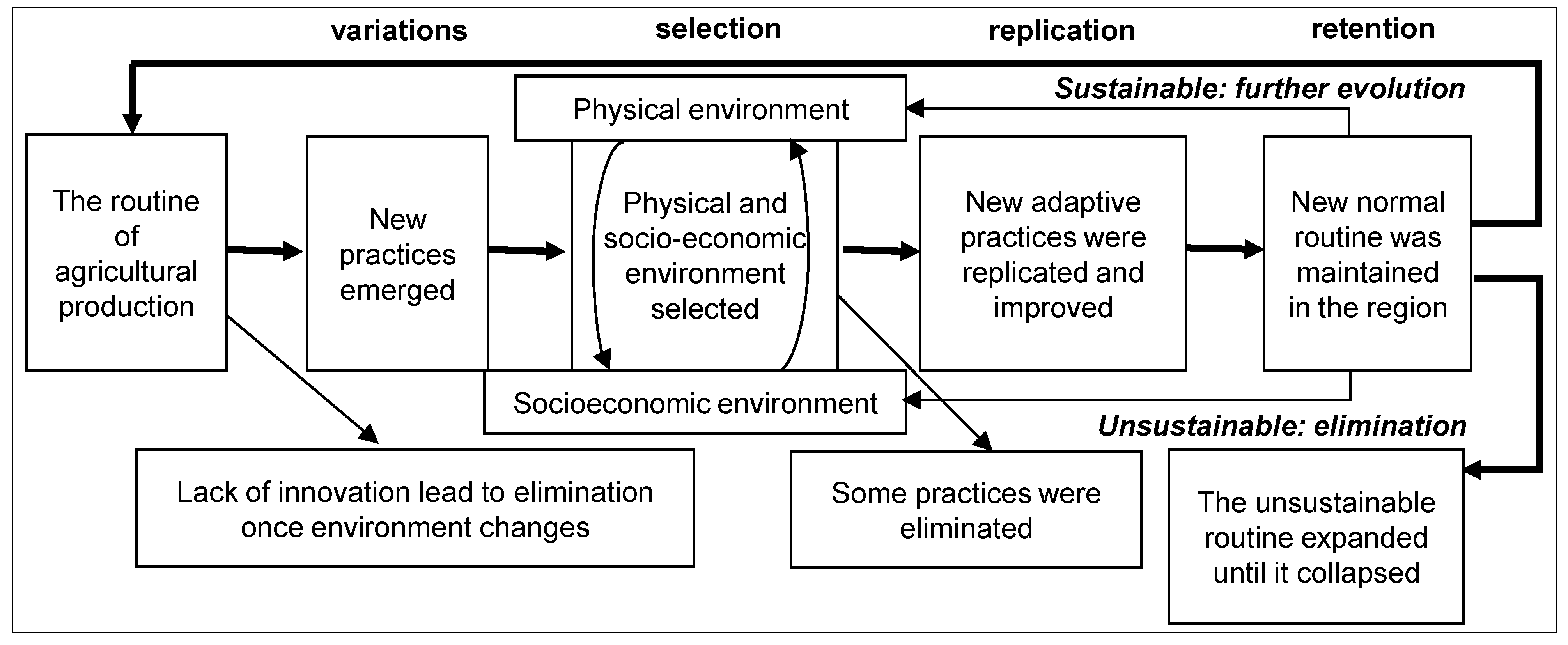
3. Methods
3.1. Background of Fuxian County
3.2. Research Design
4. Results and Discussion
4.1. Phrases of Agricultural Development in Fuxian County
| Phase | Physical environment | Socioeconomic environment |
|---|---|---|
| Phase 1 1949–1977 | Serious soil erosion; Large area | priority for food; collective production; increasing population; poor local government revenue; poor central government revenue; low productivity |
| Phase 2 1978–1998 | Serious soil erosion; Large area; Improving in part | priority for revenue; household responsibility system; large population; low local government revenue; sufficient central government revenue; improving productivity |
| Phase 3 1999–2010 | Serious soil erosion; Large area; Improving in part | priority for composite benefits; household responsibility system; large population; low local government revenue; ample central government revenue; improved productivity |
| Phase 4 2011-now | soil erosion reducing; small area; Improving obviously | priority for composite benefits; household responsibility system; large population; subsidies declining; increasing local government revenue; ample central government revenue; relatively high productivity |
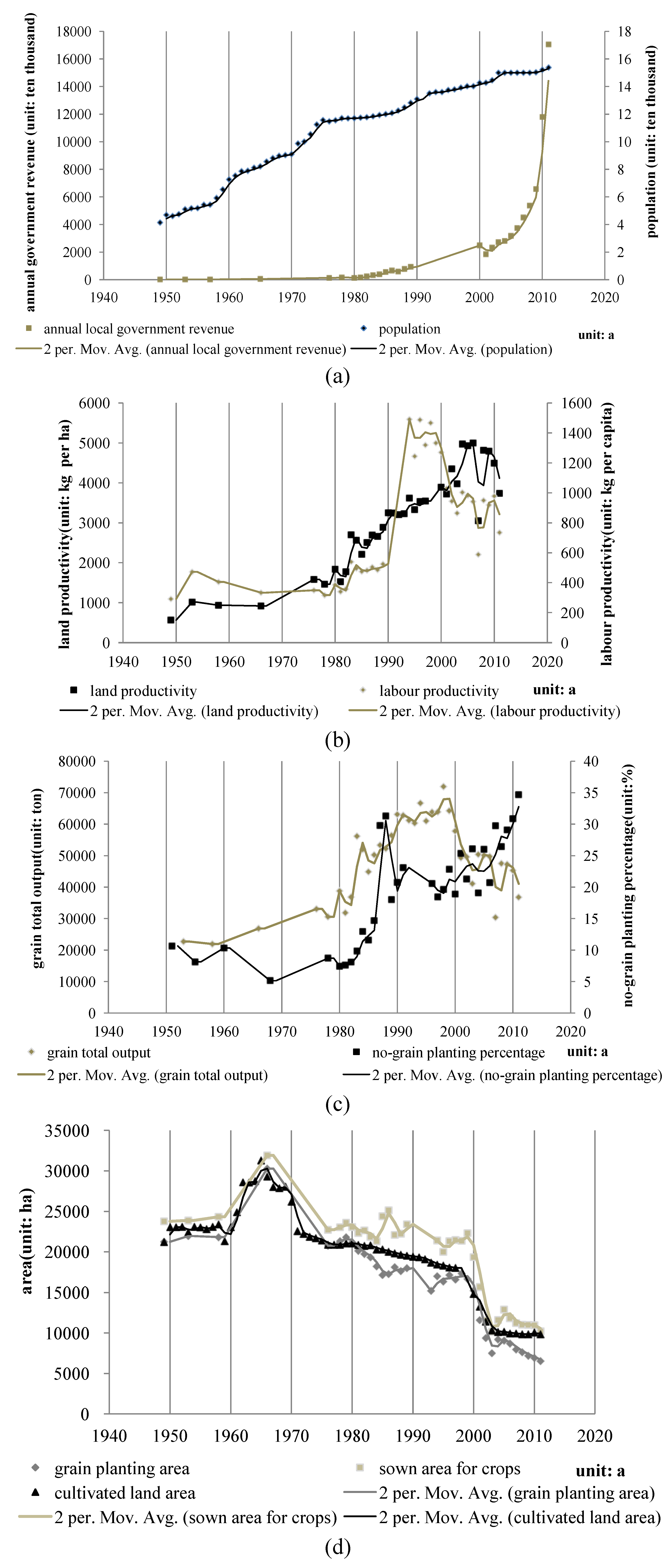
| Index item | 1949 | 1958 | 1966 | 1976 | 1989 | 2000 | 2010 |
|---|---|---|---|---|---|---|---|
| Population (ten thousand) | 4.14 | 5.92 | 8.56 | 11.48 | 12.82 | 14.26 | 15.22 |
| Local government revenue (ten thousand) | 17 | 24 | 58 | 137 | 942 | 2485 | 17051 |
| Land productivity (kg per ha) | 565 | 937 | 917 | 1583 | 2888 | 3897 | 4499 |
| Labor productivity (kg per capita) | 292 | 405 | 334 | 349 | 526 | 1270 | 978 |
| Grain total output (ton) | 11,985 | 21,900 | 26,865 | 33,077 | 56,410 | 57,802 | 45,300 |
| Agricultural machinery (unit) | 0 | 3 | 6 | 625 | 2692 | 8100 | 8204 |
| No-grain planting percentage (%) | 11 | 10 | 5 | 9 | 23 | 21 | 37 |
| Multiple cropping index (%) | 112 | 104 | 109 | 110 | 120 | 131 | 109 |
| Sown area for crops (ha) | 23,780 | 24,333 | 31,933 | 22,733 | 23,407 | 19,358 | 10,953 |
| Grain planting area (ha) | 21,247 | 21,820 | 30,293 | 20,753 | 18,000 | 15,240 | 6915 |
| Cultivated land area (ha) | 21,227 | 23,380 | 29,307 | 20,893 | 19,533 | 14,833 | 10,069 |
4.1.1. Reorganization and Collectivization

4.1.2. Reform and Opening up

4.1.3. Grain for Green Project

4.1.4. Gully Land Consolidation Project

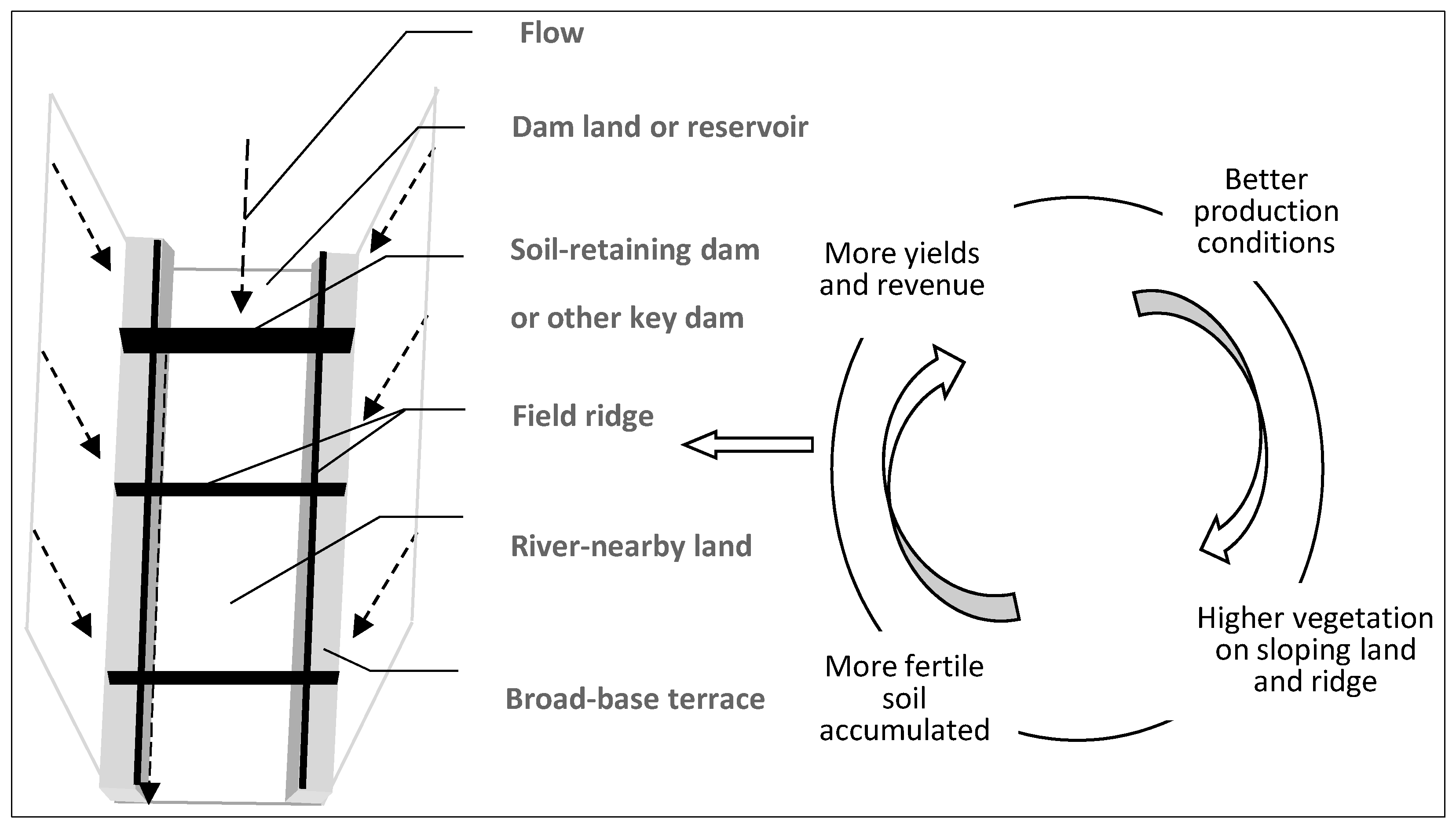
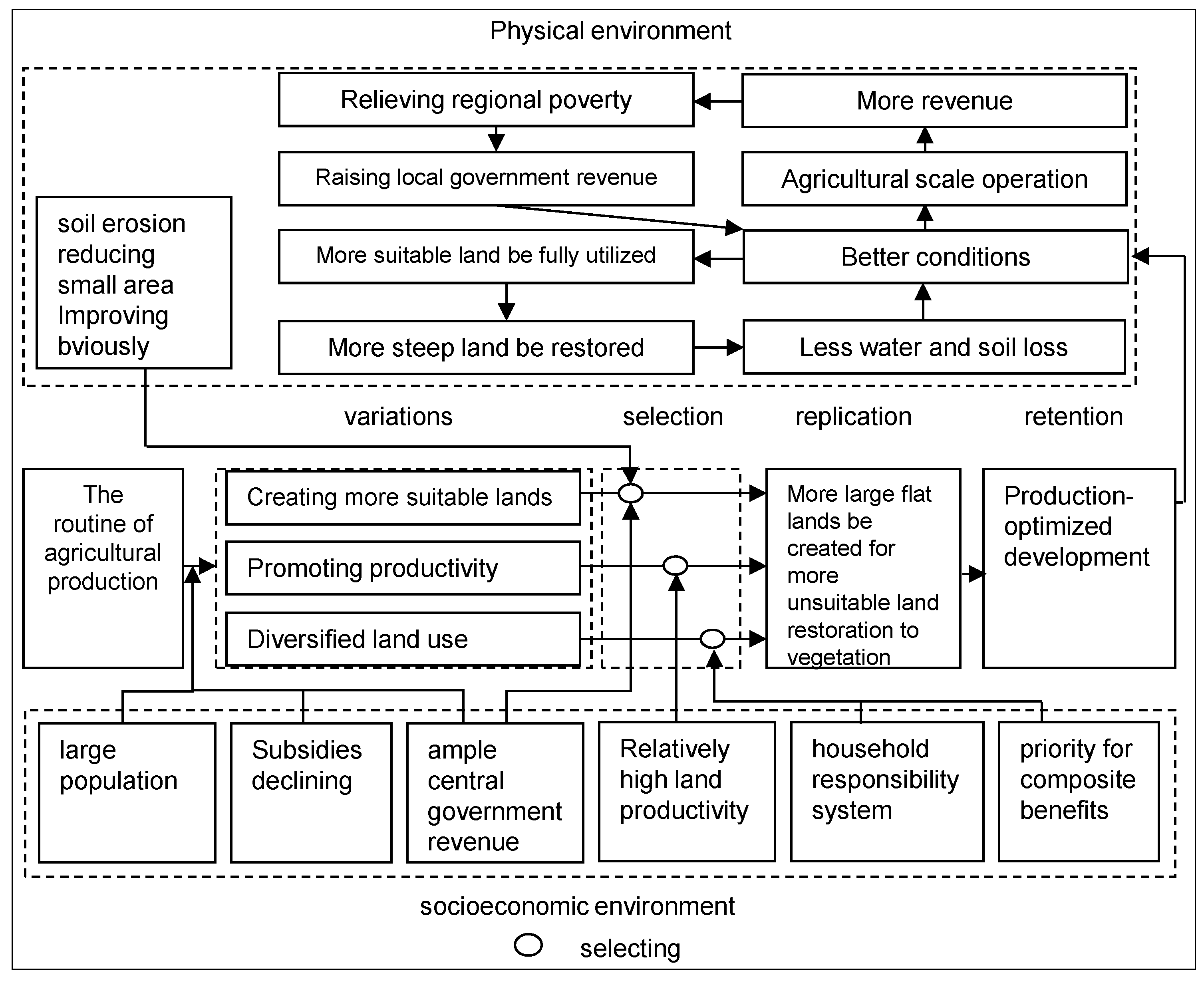

4.2. The Possible Path for Agricultural Development Transformation towards One Efficient and Sustainable Way in Fuxian County
4.2.1. The Possible Path from Serious Erosion Region to Region with More Sustainable Agriculture
| Region | Physical environment | Socioeconomic environment |
|---|---|---|
| serious soil erosion regions | serious soil erosion; bad production conditions | poverty; low productivity; monoculture development |
| regions with poor production conditions | soil erosion be improved; bad production conditions | poverty; low productivity; diversified development |
| production-optimized regions | soil erosion be improved; good production conditions | poverty; improving productivity; diversified development |
| regions with developed agriculture | soil erosion be improved; good production conditions | affluence; high productivity; agricultural modernization |
| regions with sustainable agriculture | soil erosion be improved; good production conditions | affluence; high productivity; agricultural ecologicalization |
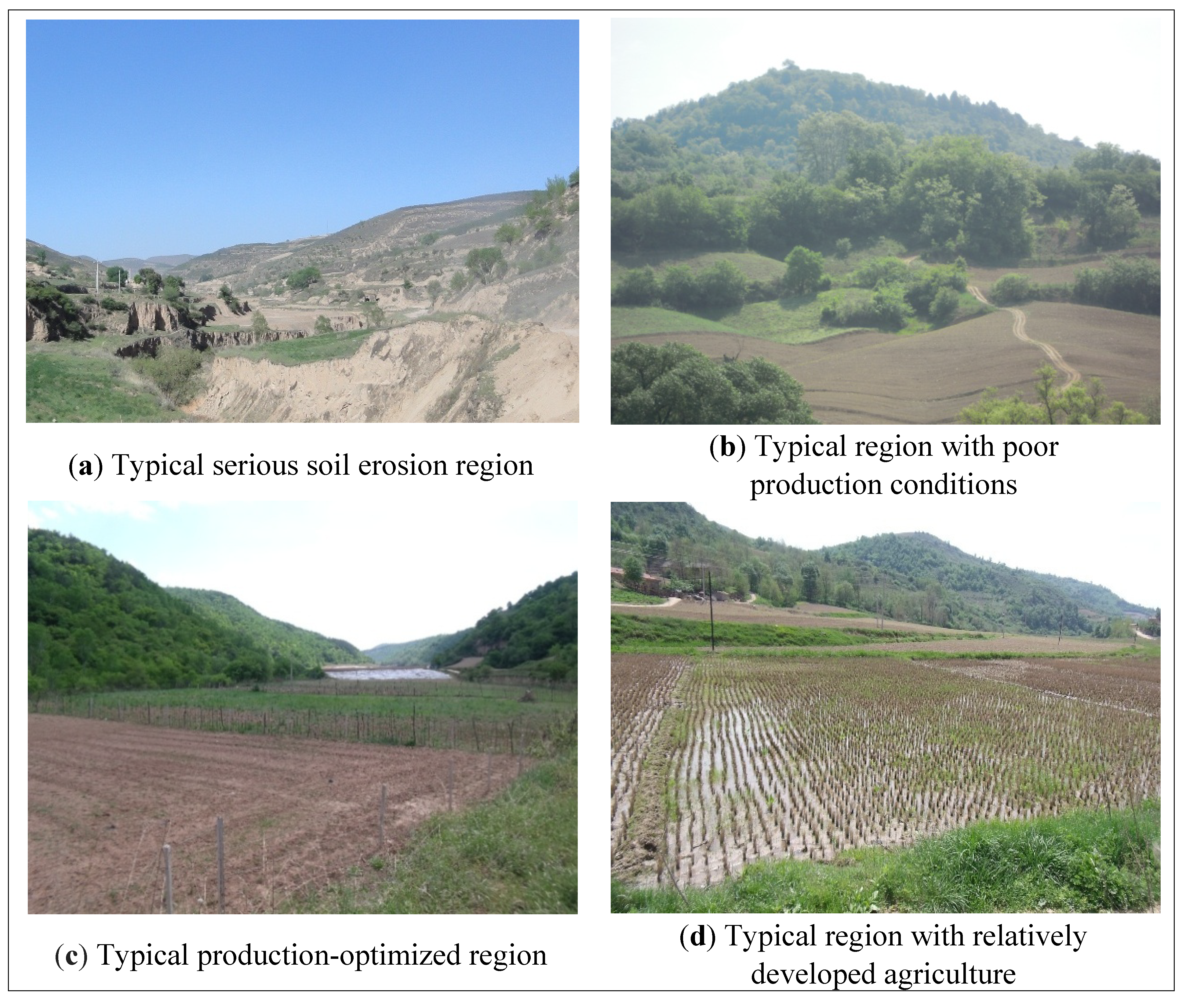
4.2.2. How to Achieve an Efficient and Sustainable Routine?
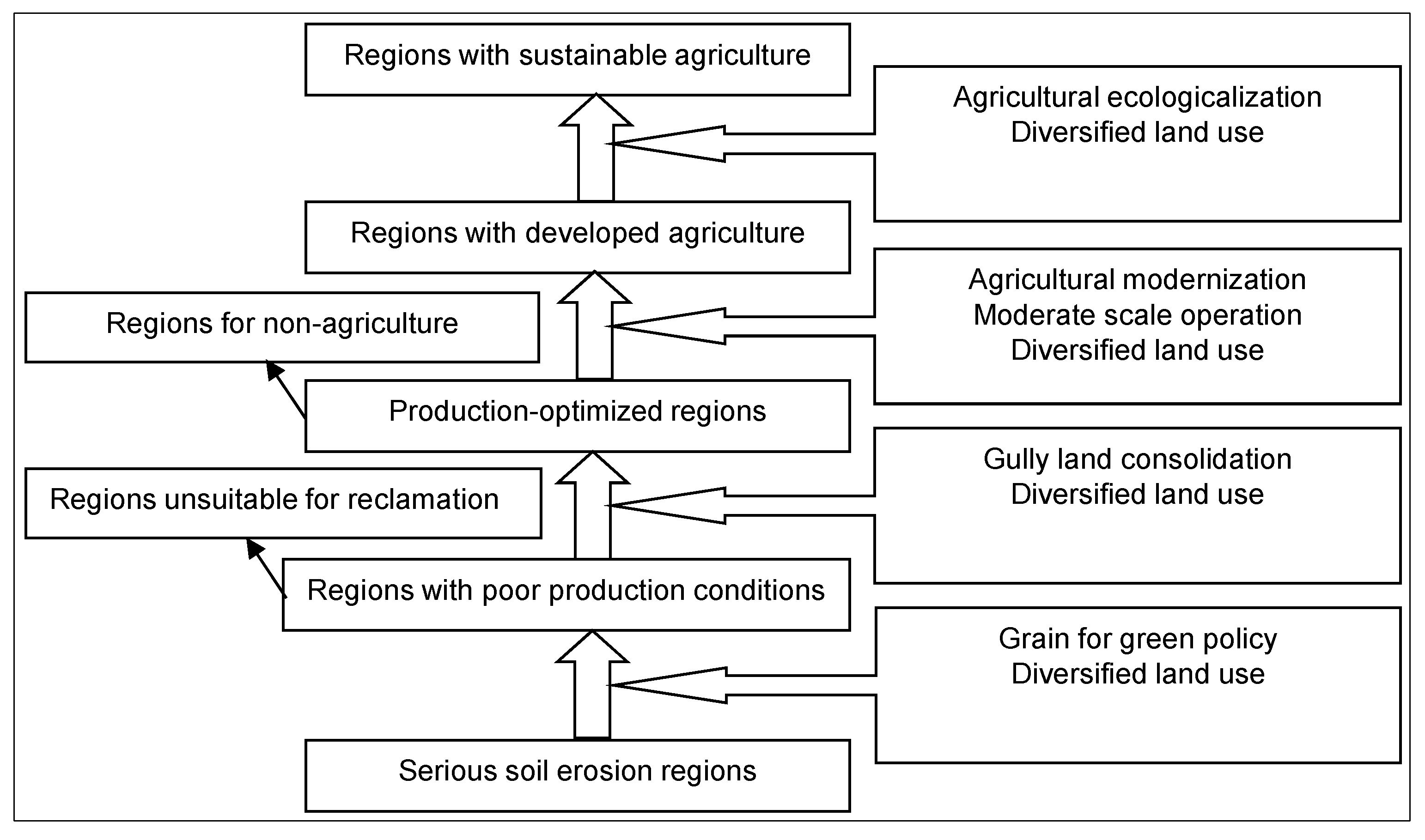
5. Conclusions
Acknowledgments
Author Contributions
Conflicts of Interest
References
- Wang, T.; Wu, J.; Kou, X. Ecologically asynchronous agricultural practice erodes sustainability of the Loess Plateau of China. Ecol. Appl. 2010, 20, 1126–1135. [Google Scholar] [CrossRef]
- Yang, W.; Yu, C. Regional Treatment and Evaluation in Loess Plateau; (in Chinese). Science Press: Beijing, China, 1992. [Google Scholar]
- Lu, Z.; Liang, Y.; Liu, G. Ecological Agriculture in Loess Plateau, China; (in Chinese). Shaanxi Science and Technology Press: Xi’an, China, 1997. [Google Scholar]
- Wu, Y.; Yang, W. Forest and Grassland Vegetation Construction and its Sustainable Development in Loess Plateau; (in Chinese). Science Press: Beijing, China, 1998. [Google Scholar]
- Ritsema, C.J. Introduction: Soil erosion and participatory land use planning on the Loess Plateau in China. Catena 2003, 54, 1–5. [Google Scholar] [CrossRef]
- Fagerström, M.H.H.; Messing, I.; Wen, Z.M.; Trouwborst, K.O.; Xu, M.X.; Zang, X.P.; Olsson, C.; Andersson, C. A participatory approach for integrated conservation planning in a small catchment in Loess Plateau, China-Part II. Analysis and findings. Catena 2003, 54, 271–288. [Google Scholar] [CrossRef]
- Ostwald, M.; Chen, D. Land-use change: Impacts of climate variations and policies among small-scale farmers in the Loess Plateau, China. Land Use Policy 2006, 23, 361–371. [Google Scholar] [CrossRef]
- Nolan, S.; Unkovich, M.; Shen, Y.Y.; Li, L.L.; Bellotti, W. Farming systems of the Loess Plateau, Gansu Province, China. Agric. Ecosyst. Environ. 2008, 124, 13–23. [Google Scholar] [CrossRef]
- Fu, B.; Liu, Y.; Lü, Y.; He, C.; Zeng, Y.; Wu, B. Assessing the soil erosion control service of ecosystems change in the Loess Plateau of China. Ecol. Complexity 2011, 8, 284–293. [Google Scholar] [CrossRef]
- COSTLOP-CAS (Comprehensive Survey Team on Loess Plateau of Chinese Academy of Sciences). The Natural Environmental Characteristics and Evolvement; (in Chinese). China Science and Technology Press: Beijing, China, 1991. [Google Scholar]
- Wang, L.; Shao, M.A.; Wang, Q.; Gale, W.J. Historical changes in the environment of the Chinese Loess Plateau. Environ. Sci. Policy 2006, 9, 675–684. [Google Scholar] [CrossRef]
- Bettinger, R.L.; Barton, L.; Richerson, P.J.; Boyd, R.; Wang, H.; Choi, W. The transition to agriculture in northwestern China. Dev. Quat. Sci. 2007, 9, 83–101. [Google Scholar]
- Fu, B. Soil erosion and its control in the loess plateau of China. Soil Use Manag. 1989, 5, 76–82. [Google Scholar] [CrossRef]
- Jiang, D. Soil Erosion and Control Models in the Loess Plateau; China Hydroelectricity Press: Beijing, China, 1997. (in Chinese) [Google Scholar]
- Chen, C.K. The Discussion of Producing and Constructing for the Loess Plateau Policy Based on Developing Commercial Production. Acta Geogr. Sinica 1981, 36, 101–107. (in Chinese). [Google Scholar]
- Liu, G. Soil conservation and sustainable agriculture on the Loess Plateau: Challenges and prospects. Ambio 1999, 28, 663–668. [Google Scholar]
- Wu, H.I.; Childress, W.M.; Li, Y.; Spenced, R.D.; Ren, J.Z. An integrated simulation model for a semi-arid agroecosystem in the Loess Plateau of northwestern China. Agric. Syst. 1996, 52, 83–111. [Google Scholar] [CrossRef]
- Huang, M.; Shao, M.; Zhang, L.; Li, Y. Water use efficiency and sustainability of different long-term crop rotation systems in the Loess Plateau of China. Soil Tillage Res. 2003, 72, 95–104. [Google Scholar] [CrossRef]
- World Bank, ICR of Loess Plateau Watershed Rehabilitation Project. Available online: http://lnweb90.worldbank.org/oed/oeddoclib.nsf/DocUNIDViewForJavaSearch/8525682E0068603785256D17004305D0?OpenDocument (accessed on 27 June 2003).
- Chen, S.J.; Wang, Y.; Wang, Y.J. The Loess Plateau Watershed Rehabilitation Project. In Proceedings of the Scaling up Poverty Reduction: A Global Learning Process and Conference, Shanghai, China, 25–27 May 2004.
- Lei, D.; Shangguan, Z.P.; Li, R. Effects of the grain-for-green program on soil erosion in China. Int. J. Sediment Res. 2012, 27, 120–127. [Google Scholar] [CrossRef]
- Zhou, D.; Zhao, S.; Zhu, C. The Grain for Green Project induced land cover change in the Loess Plateau: A case study with Ansai County, Shanxi Province, China. Ecol. Indic. 2012, 23, 88–94. [Google Scholar] [CrossRef]
- Wang, J.J.; Jiang, Z.D.; Xia, Z.L. Grain-for-Green Policy and Its Achievements. In Restoration and Development of the Degraded Loess Plateau, China, 2nd ed.; Tsunekawa, A., Liu, G., Yamanaka, N., Du, S., Eds.; Springer: Tokyo, Japan, 2014; pp. 137–147. [Google Scholar]
- Uchida, E.; Xu, J.; Xu, Z.; Scott, R. Are the poor benefiting from China’s land conservation program? Environ. Dev. Econ. 2007, 4, 593–620. [Google Scholar] [CrossRef]
- Bennett, M.T. China’s sloping land conversion program: Institutional innovation or business as usual? Ecol. Econ. 2008, 4, 699–711. [Google Scholar] [CrossRef]
- Liang, Y.; Li, S.; Feldman, M.W.; Daily, G.C. Does household composition matter? The impact of the Grain for Green Program on rural livelihoods in China. Ecol. Econ. 2012, 75, 152–160. [Google Scholar] [CrossRef]
- Shi, M.; Wang, T. An application of bio-economic household model to analysis on man-land relationship behavior in ecologically fragile land of China. Acta Geogr. Sinica 2005, 60, 165–174. (In Chinese) [Google Scholar]
- Cao, S.; Xu, C.; Chen, L.; Wang, X. Attitudes of farmers in China’s northern Shaanxi Province towards the land-use changes required under the Grain for Green Project, and implications for the project’s success. Land Use Policy 2009, 26, 1182–1194. [Google Scholar]
- Liu, Z.; Li, B. Spatial and temporal changes in grain production before and after implementation of Grain for Green project in Loess Plateau region. Trans. Chin. Soc. Agric. Eng. 2012, 11, 1–8. (In Chinese) [Google Scholar]
- Bullock, A.; King, B. Evaluating China’s slope land conversion program as sustainable management in Tianquan and Wuqi Counties. J. Environ. Manag. 2011, 8, 1916–1922. [Google Scholar] [CrossRef]
- World Bank; ICR of Second Loess Plateau Watershed Rehabilitation Project. Available online: http://web.worldbank.org/external/projects/main?pagePK=104231&piPK=73230&theSitePK=40941&menuPK=228424&Projectid=P056216 (accessed on 4 May 2014).
- Scoones, I. Climate change and the challenge of non-equilibrium thinking. IDS Bull. 2004, 35, 11–15. [Google Scholar] [CrossRef] [Green Version]
- Tang, Q.; Bennett, S.J.; Xu, Y.; Li, Y. Agricultural practices and sustainable livelihoods: Rural transformation within the Loess Plateau, China. Appl. Geogr. 2013, 41, 15–23. [Google Scholar] [CrossRef]
- Zhao, X.Z.; Li, F.M.; Mo, F. Integrated conservation solutions for the endangered Loess Plateau of northwest China. Pak. J. Bot. 2012, 44, 77–83. [Google Scholar]
- Chen, L.; Yang, L.; Wei, W.; Wang, Z.; Mo, B.; Cai, G. Towards sustainable integrated watershed ecosystem management: A case study in Dingxi on the Loess Plateau, China. Environ. Manag. 2013, 1, 126–137. [Google Scholar]
- China Land and Resources News, revitalizing good Northern Shaanxi. 2012. Available online: http://special.gtzyb.com/121120/ (accessed on 4 March 2014). (In Chinese)
- Liu, Q.; Wang, Y.; Zhang, J.; Chen, Y. Filling gullies to create farmland on the Loess Plateau. Environ. Sci. Technol. 2013, 14, 7589–7590. [Google Scholar]
- Jin, Z. The creation of farmland by gully filling on the Loess Plateau: A double-edged sword. Environ. Sci. Technol. 2014, 2, 883–884. [Google Scholar] [CrossRef]
- Jiao, J. Countermeasures to Prevent Water Erosion in the Loess Plateau of China. In Restoration and Development of the Degraded Loess Plateau, China, 2nd ed.; Tsunekawa, A., Liu, G., Yamanaka, N., Du, S., Eds.; Springer: Tokyo, Japan, 2014; pp. 183–198. [Google Scholar]
- Gruen, R.L.; Elliott, J.H.; Nolan, M.L. Sustainability science: An integrated approach for health-program planning. The Lancet 2008, 372, 1579–1589. [Google Scholar] [CrossRef]
- Jerneck, A.; Olsson, L.; Ness, B. Structuring sustainability science. Sustain. Sci. 2011, 6, 69–82. [Google Scholar] [CrossRef]
- Lang, D.J.; Wiek, A.; Bergmann, M. Transdisciplinary research in sustainability science: Practice, principles, and challenges. Sustain. Sci. 2012, 7, 25–43. [Google Scholar] [CrossRef]
- Mascarelli, A. Sustainability: Environmental puzzle solvers. Nature 2013, 494, 507–509. [Google Scholar] [CrossRef]
- Genus, A. Governing sustainability: A discourse-institutional approach. Sustainability 2014, 6, 283–305. [Google Scholar] [CrossRef]
- Douglass, G. Agricultural Sustainability in a Changing World Order; Westview Press: Boulder, CO, USA, 1984. [Google Scholar]
- Schaller, N. The concept of agricultural sustainability. Agric. Ecosyst. Environ. 1993, 46, 89–97. [Google Scholar] [CrossRef]
- Ruttan, V.W. The transition to agricultural sustainability. Proc. Natl. Acad. Sci. USA 1999, 96, 5960–5967. [Google Scholar] [CrossRef]
- Pretty, J. Agricultural sustainability: Concepts, principles and evidence. Philos. Trans. R. Soc. B 2008, 363, 447–465. [Google Scholar] [CrossRef]
- Gómez-Limón, J.A.; Sanchez-Fernandez, G. Empirical evaluation of agricultural sustainability using composite indicators. Ecol. Econ. 2010, 69, 1062–1075. [Google Scholar] [CrossRef]
- Hazell, P.; Wood, S. Drivers of change in global agriculture. Philos. Trans. R. Soc. B 2008, 363, 495–515. [Google Scholar] [CrossRef]
- Liu, G.; Tsunekawa, A.; Dang, X. Future Development-Related Challenges on the Loess Plateau. In Restoration and Development of the Degraded Loess Plateau, China, 2nd ed.; Tsunekawa, A., Liu, G., Yamanaka, N., Du, S., Eds.; Springer: Tokyo, Japan, 2014; pp. 267–282. [Google Scholar]
- Lv, X.; Yu, X.; Fan, D. Estimation of non-point source pollution loads caused by soil erosion in China. J. Food Agric. Environ. 2012, 10, 1045–1050. [Google Scholar]
- Liu, W.; Xing, M. Isotopic indicators of carbon and nitrogen cycles in river catchments during soil erosion in the arid Loess Plateau of China. Chem. Geol. 2012, 296, 66–72. [Google Scholar] [CrossRef]
- Ma, J.; Pan, F.; He, J. Petroleum pollution and evolution of water quality in the Malian River Basin of the Longdong Loess Plateau, Northwestern China. Environ. Earth Sci. 2012, 66, 1769–1782. [Google Scholar] [CrossRef]
- Hu, Y.; Wang, D.; Wei, L.; Sun, B. Heavy metal contamination of urban topsoils in a typical region of Loess Plateau, China. J. Soils Sediments 2014, 14, 928–935. [Google Scholar] [CrossRef]
- Li, Z.; Zheng, F.; Liu, W. Spatial distribution and temporal trends of extreme temperature and precipitation events on the Loess Plateau of China during 1961–2007. Quat. Int. 2010, 226, 92–100. [Google Scholar] [CrossRef]
- Li, Z.; Zheng, F.L.; Liu, W.Z. Spatially downscaling GCMs outputs to project changes in extreme precipitation and temperature events on the Loess Plateau of China during the 21st Century. Glob. Planet. Change 2012, 82, 65–73. [Google Scholar]
- Wan, L.; Zhang, X.P.; Ma, Q.; Zhang, J.J.; Ma, T.Y.; Sun, Y.P. Spatiotemporal characteristics of precipitation and extreme events on the Loess Plateau of China between 1957 and 2009. Available online: http://onlinelibrary.wiley.com/doi/10.1002/hyp.9951/pdf (accessed on 21 August 2013).
- Nelson, R.R.; Winter, S.G. An Evolutionary Theory of Economic Change; Harvard Business School Press: Cambridge, UK, 1982. [Google Scholar]
- Hammerstein, P.; Hagen, E.H. The second wave of evolutionary economics in biology. Trends Ecol. Evol. 2005, 20, 604–609. [Google Scholar] [CrossRef]
- Ruth, M. Evolutionary economics at the crossroads of biology and physics. J. Soc. Evol. Syst. 1996, 19, 125–144. [Google Scholar] [CrossRef]
- Powell, J.H.; Wakeley, T.M. Evolutionary concepts and business economics: Towards a normative approach. J. Bus. Res. 2003, 56, 153–161. [Google Scholar] [CrossRef]
- Nelson, R.R. Economic development from the perspective of evolutionary economic theory. Oxford Dev. Stud. 2008, 1, 9–21. [Google Scholar] [CrossRef]
- Foxon, T.J. Responding to the financial crisis: Need for a new economics. Environ. Innov. Soc. Transform. 2013, 6, 126–128. [Google Scholar] [CrossRef]
- Foster, J.; Metcalfe, J.S. Economic emergence: An evolutionary economic perspective. J. Econ. Behav. Org. 2012, 82, 420–432. [Google Scholar] [CrossRef]
- Safarzyńska, K.; Frenken, K.; van den Bergh, J.C. Evolutionary theorizing and modeling of sustainability transformations. Res. Policy 2012, 41, 1011–1024. [Google Scholar] [CrossRef]
- Foster, J. The analytical foundations of evolutionary economics: From biological analogy to economic self-organization. Struct. Change Econ. Dyn. 1997, 8, 427–451. [Google Scholar] [CrossRef]
- Gowdy, J. Avoiding self-organized extinction: Toward a co-evolutionary economics of sustainability. Int. J. Sustain. Dev. World Ecol. 2007, 1, 27–36. [Google Scholar] [CrossRef]
- Nill, J.; Kemp, R. Evolutionary approaches for sustainable innovation policies: From niche to paradigm? Res. Policy 2009, 38, 668–680. [Google Scholar] [CrossRef]
- Kogut, B.; Zander, U. Knowledge of the firm and the evolutionary theory of the multinational corporation. J. Int. Bus. Stud. 1993, 24, 625–645. [Google Scholar] [CrossRef]
- Zollo, M.; Winter, S.G. Deliberate learning and the evolution of dynamic capabilities. Org. Sci. 2002, 13, 339–351. [Google Scholar] [CrossRef]
- Brennan, R. Evolutionary economics and the markets-as-networks approach. Ind. Mark. Manag. 2006, 35, 829–838. [Google Scholar] [CrossRef]
- Becker, M.; Lazaric, N.; Nelson, R.R.; Winter, S.G. Applying organizational routines in understanding organizational change. Ind. Corp. Change 2005, 14, 775–791. [Google Scholar] [CrossRef]
- Liu, J.; Chen, J.; Fang, S.; Li, Q. Chinese agricultural policies in thirty years and analysis on the effects. China Popul. Resour. Environ. 2008, 18, 1–6. [Google Scholar] [CrossRef]
- Douglas, H.R. American and Chinese Agricultural Policy since 1949: An Overview. Procedia-Soc. Behav. Sci. 2010, 2, 6692–6701. [Google Scholar] [CrossRef]
- Hatani, F.; McGaughey, S.L. Network cohesion in global expansion: An evolutionary view. J. World Bus. 2013, 4, 455–465. [Google Scholar]
- Zhao, Y.T.; Chang, Q.R.; Li, C.P.; Zhang, Y.G. Study on the Spatial Variability and Distribution Pattern of Soil Available Nutrients in Gully Loess Plateau Farmland: Shaanxi Fuxian as an Example. Chin. J. Soil Sci. 2012, 43, 1438–1443. (In Chinese) [Google Scholar]
- The Local Records Compile Committee of Fuxian County. Local chronicles of Fuxian County; (In Chinese). Shaanxi People’s Publishing House Press: Xi’an, China, 1994. [Google Scholar]
- Sachs, J.D.; Woo, W.T. Understanding China’s economic performance. J. Policy Reform 2001, 1, 1–50. [Google Scholar]
- Yao, Y. The Chinese growth miracle. Handbook Econ. Growth 2014, 2, 943–1031. [Google Scholar] [CrossRef]
- Feng, Z.; Yang, Y.; Zhang, Y.; Zhang, P.; Li, Y. Grain-for-green policy and its impacts on grain supply in West China. Land Use Policy 2005, 22, 301–312. [Google Scholar] [CrossRef]
- Xu, Z.; Xu, J.; Deng, X.; Huang, J.; Uchida, E.; Rozelle, S. Grain for green versus grain: Conflict between food security and conservation set-aside in China. World Dev. 2006, 34, 130–148. [Google Scholar] [CrossRef]
- Xu, X.; Zhong, H.; Zhong, O. Development of check-damsystems in gullies on the Loess Plateau, China. Environ. Sci. Policy 2004, 7, 79–86. [Google Scholar] [CrossRef]
- Ran, D.; Luo, Q.; Liu, B. Effect of check-dams on flood and sediment reduction in middle reaches of Yellow River. J. Hydraul. Eng. 2004, 5, 7–13. (In Chinese) [Google Scholar]
- Liu, Y.H. Land Type and Their Assessment on the Loess Plateau of Northern Shaanxi Province. Acta Geogr. Sinica 1985, 40, 121–129. (In Chinese) [Google Scholar]
- Li, Z.; Cai, G.; Zeng, G. Simulation on relations between land use type and land productivity in Loess Hilly Region: A case study in Wangjiagou catchment. Scientia Geogr. Sinica 2007, 27, 53–57. [Google Scholar]
- Li, Z.; Liu, W.; Zhang, X.; Zheng, F. Impacts of land use change and climate variability on hydrology in an agricultural catchment on the Loess Plateau of China. J. Hydrol. 2009, 377, 35–42. [Google Scholar] [CrossRef]
© 2014 by the authors; licensee MDPI, Basel, Switzerland. This article is an open access article distributed under the terms and conditions of the Creative Commons Attribution license (http://creativecommons.org/licenses/by/3.0/).
Share and Cite
Guo, Y.; Liu, Y.; Wen, Q.; Li, Y. The Transformation of Agricultural Development towards a Sustainable Future from an Evolutionary View on the Chinese Loess Plateau: A Case Study of Fuxian County. Sustainability 2014, 6, 3644-3668. https://doi.org/10.3390/su6063644
Guo Y, Liu Y, Wen Q, Li Y. The Transformation of Agricultural Development towards a Sustainable Future from an Evolutionary View on the Chinese Loess Plateau: A Case Study of Fuxian County. Sustainability. 2014; 6(6):3644-3668. https://doi.org/10.3390/su6063644
Chicago/Turabian StyleGuo, Yanjun, Yansui Liu, Qi Wen, and Yurui Li. 2014. "The Transformation of Agricultural Development towards a Sustainable Future from an Evolutionary View on the Chinese Loess Plateau: A Case Study of Fuxian County" Sustainability 6, no. 6: 3644-3668. https://doi.org/10.3390/su6063644
APA StyleGuo, Y., Liu, Y., Wen, Q., & Li, Y. (2014). The Transformation of Agricultural Development towards a Sustainable Future from an Evolutionary View on the Chinese Loess Plateau: A Case Study of Fuxian County. Sustainability, 6(6), 3644-3668. https://doi.org/10.3390/su6063644





